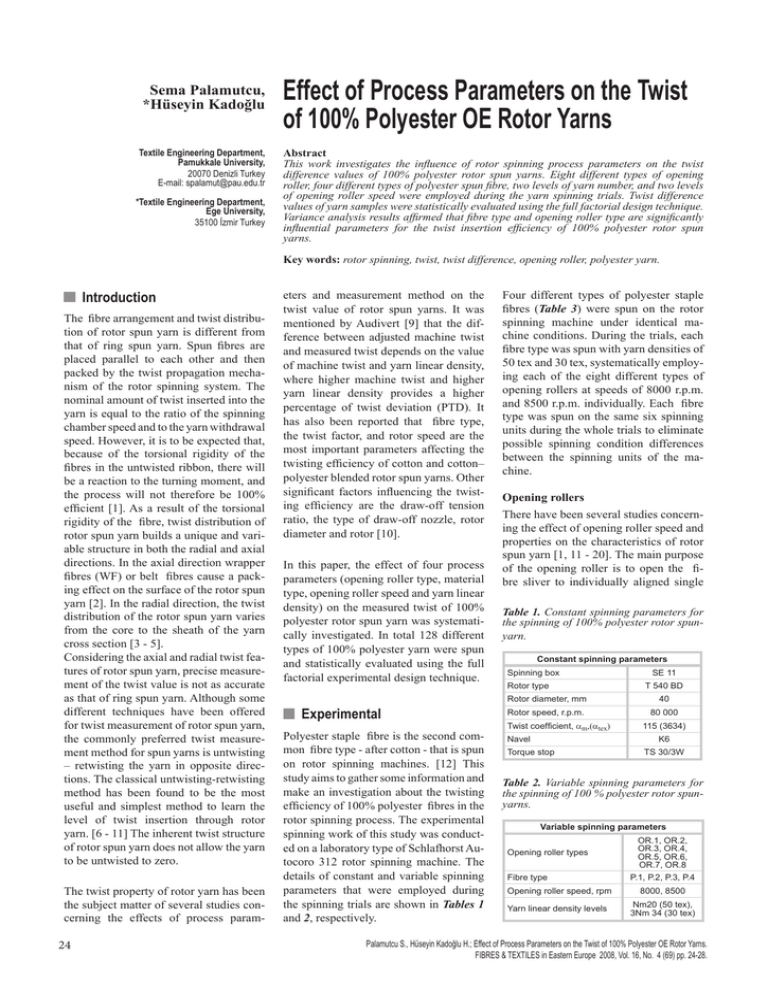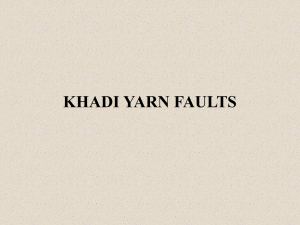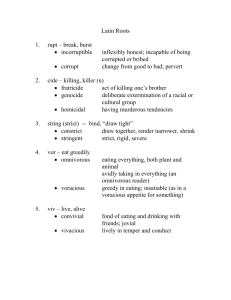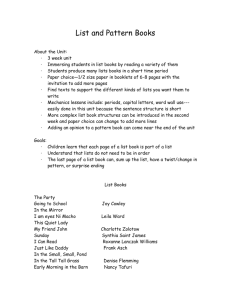n Introduction
advertisement

Sema Palamutcu, *Hüseyin Kadoğlu Textile Engineering Department, Pamukkale University, 20070 Denizli Turkey E-mail: spalamut@pau.edu.tr *Textile Engineering Department, Ege University, 35100 İzmir Turkey Effect of Process Parameters on the Twist of 100% Polyester OE Rotor Yarns Abstract This work investigates the influence of rotor spinning process parameters on the twist difference values of 100% polyester rotor spun yarns. Eight different types of opening roller, four different types of polyester spun fibre, two levels of yarn number, and two levels of opening roller speed were employed during the yarn spinning trials. Twist difference values of yarn samples were statistically evaluated using the full factorial design technique. Variance analysis results affirmed that fibre type and opening roller type are significantly influential parameters for the twist insertion efficiency of 100% polyester rotor spun yarns. Key words: rotor spinning, twist, twist difference, opening roller, polyester yarn. n Introduction The fibre arrangement and twist distribution of rotor spun yarn is different from that of ring spun yarn. Spun fibres are placed parallel to each other and then packed by the twist propagation mechanism of the rotor spinning system. The nominal amount of twist inserted into the yarn is equal to the ratio of the spinning chamber speed and to the yarn withdrawal speed. However, it is to be expected that, because of the torsional rigidity of the fibres in the untwisted ribbon, there will be a reaction to the turning moment, and the process will not therefore be 100% efficient [1]. As a result of the torsional rigidity of the fibre, twist distribution of rotor spun yarn builds a unique and variable structure in both the radial and axial directions. In the axial direction wrapper fibres (WF) or belt fibres cause a packing effect on the surface of the rotor spun yarn [2]. In the radial direction, the twist distribution of the rotor spun yarn varies from the core to the sheath of the yarn cross section [3 - 5]. Considering the axial and radial twist features of rotor spun yarn, precise measurement of the twist value is not as accurate as that of ring spun yarn. Although some different techniques have been offered for twist measurement of rotor spun yarn, the commonly preferred twist measurement method for spun yarns is untwisting – retwisting the yarn in opposite directions. The classical untwisting-retwisting method has been found to be the most useful and simplest method to learn the level of twist insertion through rotor yarn. [6 - 11] The inherent twist structure of rotor spun yarn does not allow the yarn to be untwisted to zero. The twist property of rotor yarn has been the subject matter of several studies concerning the effects of process param- 24 eters and measurement method on the twist value of rotor spun yarns. It was mentioned by Audivert [9] that the difference between adjusted machine twist and measured twist depends on the value of machine twist and yarn linear density, where higher machine twist and higher yarn linear density provides a higher percentage of twist deviation (PTD). It has also been reported that fibre type, the twist factor, and rotor speed are the most important parameters affecting the twisting efficiency of cotton and cotton– polyester blended rotor spun yarns. Other significant factors influencing the twisting efficiency are the draw-off tension ratio, the type of draw-off nozzle, rotor diameter and rotor [10]. In this paper, the effect of four process parameters (opening roller type, material type, opening roller speed and yarn linear density) on the measured twist of 100% polyester rotor spun yarn was systematically investigated. In total 128 different types of 100% polyester yarn were spun and statistically evaluated using the full factorial experimental design technique. n Experimental Polyester staple fibre is the second common fibre type - after cotton - that is spun on rotor spinning machines. [12] This study aims to gather some information and make an investigation about the twisting efficiency of 100% polyester fibres in the rotor spinning process. The experimental spinning work of this study was conducted on a laboratory type of Schlafhorst Autocoro 312 rotor spinning machine. The details of constant and variable spinning parameters that were employed during the spinning trials are shown in Tables 1 and 2, respectively. Four different types of polyester staple fibres (Table 3) were spun on the rotor spinning machine under identical machine conditions. During the trials, each fibre type was spun with yarn densities of 50 tex and 30 tex, systematically employing each of the eight different types of opening rollers at speeds of 8000 r.p.m. and 8500 r.p.m. individually. Each fibre type was spun on the same six spinning units during the whole trials to eliminate possible spinning condition differences between the spinning units of the machine. Opening rollers There have been several studies concerning the effect of opening roller speed and properties on the characteristics of rotor spun yarn [1, 11 - 20]. The main purpose of the opening roller is to open the fibre sliver to individually aligned single Table 1. Constant spinning parameters for the spinning of 100% polyester rotor spunyarn. Constant spinning parameters Spinning box Rotor type SE 11 T 540 BD Rotor diameter, mm 40 Rotor speed, r.p.m. 80 000 Twist coefficient, αm,(αtex) Navel 115 (3634) K6 Torque stop TS 30/3W Table 2. Variable spinning parameters for the spinning of 100 % polyester rotor spunyarns. Variable spinning parameters Opening roller types Fibre type OR.1, OR.2, OR.3, OR.4, OR.5, OR.6, OR.7, OR.8 P.1, P.2, P.3, P.4 Opening roller speed, rpm 8000, 8500 Yarn linear density levels Nm20 (50 tex), 3Nm 34 (30 tex) Palamutcu S., Hüseyin Kadoğlu H.; Effect of Process Parameters on the Twist of 100% Polyester OE Rotor Yarns. FIBRES & TEXTILES in Eastern Europe 2008, Vol. 16, No. 4 (69) pp. 24-28. fibres. The efficiency of opening fibre on the roller surface depends on the total opening force affecting the fibres, caused by the opening roller tooth [16]. Well straightened, aligned and parallelised fibres of the opened sliver are expected to built efficiently twisted rotor yarn bodies. It was reported by Tyagi [11] that there is a marked increase in twist efficiency with an increase in opening roller speed. The increase in twist efficiency is the result of a decrease in the percentage of sheath fibres. Greater fibre separation at higher opening roller speeds reduces the possibility of some fibres becoming wrapper simply because they happen to entangle with the fibres undergoing belt formation. Ülkü’s approach [14] concerning the effect of opening roller speed on the twist efficiency is also similar to Tyagi’s; in their work they mention that there is only a small degree of association between opening roller speed and twist. The slightly increased number of twists for high opening roller speeds can be attributed to the high degree of fibre separation at high speeds [15]. Table 4 shows basic properties of the opening rollers, which were chosen from among current commercial opening rollers, employed during the trials. They differ from each other concerning the tooth shape, number of teeth per unit area and surface coating properties [12]. Twist measurement The twist level of the rotor yarn specimens were measured using the untwisting-retwisting method. The purpose of employ this method was not to determine the real twist level of the specimens but to establish a comparable twist value database for the specimens, which were of the same linear density and spun using different opening rollers and opening roller speeds. The twist value of the yarn samples was measured according to Standard DIN EN-ISO 2061 using a Zweigle D303 automatic twist tester in the accredited textile laboratory of Schlafhorst in Mönchengladbach, Germany. The testing length was 500 mm and the pretension weight equal to 0.6 cN/tex, which are practically used values for twist difference measurements of OE rotor yarns [21]. Each of the six packages of yarn samples was tested 20 times individually, and the mean of the 20 test results was used as the measured yarn twist value of each yarn package. As pointed out earlier, the twist FIBRES & TEXTILES in Eastern Europe 2008, Vol. 16, No. 4 (69) Table 3. Raw material properties. Code of fibre types Fibre linear density, dtex Sliver number, ktex P.1 P.2 P.3 P.4 1.30 1.51 1.37 1.63 5 5 5 5 2,5% span length, mm 26.7 26.7 37.3 36.2 Sliver strength, cN/ktex 60.21 61.97 68.41 67.49 Sliver elongation at breaking, % 7.02 6.28 18.84 18.22 Fibre crimp, 1/cm 7.12 7.43 7.02 7.09 Table 4. Opening roller properties. Code Commercial name Teeth per unit area, teeth/cm2 Surface coating OR.1 S 21 DN 16,5 diamondnickel OR.2 S 21 N 16,5 nickel OR.3 S 21 D 16,5 diamond OR.4 S 22 P 11,6 plasma OR.5 OS21DN 13,2 diamondnickel OR.6 S 43 N 10,7 nickel OR.7 NW 20 3,23 - OR.8 S 25 D 8,9 diamond Teeth shape measured does not indicate the true twist level of the yarn because of the irregular twist structure and wrapping fibres of rotor spun yarn. However, the objective of the current study was to investigate the effect of the above- mentioned spinning parameters on the percentage twist deviation (PTD) [9], twist insertion efficiency [10], and % twist difference values (T% ) [21] of the yarn samples. Since the same testing procedure was applied for all the yarn specimens, the twist measurement method should not have any influence on the validity of the work. Twist measurement tests were performed under a standard atmosphere of 20 ± 2 ºC and 65 ± 2% RH. The untwisting-retwisting method of twist measurement only gives some idea about the level of rotor yarn twist that is untwistable. There are always some differences between the machine twist and that of the of rotor spun yarn measured. 25 Table 5. Twist difference%T values of 100% polyester yarns, (turns / m); *measurement can not be done. Yarn density, tex Fibre types P1 P2 30 P3 P4 P1 P2 50 P3 P4 Opening roller speed, r.p.m. 8 000 OR.1 OR.2 OR.3 OR.4 OR.5 OR.6 OR.7 OR.8 -58.27 -59.57 -54.80 -62.18 -59.73 -59.68 -56.87 -46.38 8 500 -60.33 -53.73 -42.65 -59.48 -49.15 -48.55 -52.10 -38.07 8 000 -50.43 -52.47 -37.42 -53.80 -53.35 -128.7 -56.22 -53.40 8 500 -49.80 -53.48 -32.82 -50.12 -38.63 -53.27 -52.15 -48.32 8 000 -71.36 -73.92 -71.97 -70.47 -63.73 -70.36 -52.03 -72.05 8 500 -70.77 -71.80 -67.35 -70.82 -24.82 -49.27 -26.95 -65.55 8 000 -44.08 -43.05 -12.18 -28.72 -13.83 -50.47 -53.10 -15.33 8 500 -41.93 -43.58 -12.18 -28.72 -13.83 -46.02 -36.40 -15.33 8 000 -4.64 -7.63 -16.75 -8.94 -4.50 -3.48 -4.52 -4.96 8 500 -10.56 -5.43 -1.08 -2.64 -16.18 -3.32 -8.30 -2.58 8 000 -32.57 -22.84 -33.65 -24.50 -29.65 -33.70 -18.03 -35.77 8 500 -16.50 -24.07 -29.57 -33.07 -35.67 -23.67 -14.95 -5.35 8 000 -59.07 -50.70 -61.25 -58.95 -61.87 -63.02 -66.27 -65.32 8 500 -61.42 -59.78 -64.60 -46.63 -53.45 -67.22 -65.43 -60.75 8 000 -40.87 -41.00 * -30.98 * -42.82 -44.22 * 8 500 -38.27 -22.28 * * * -41.48 -40.56 * Opening roller types Deussen defines twist difference as written below and symbolises it by %T. %T = (Ta - Tm)/Tm × 100 where; %T = twist difference, Ta = adjusted machine twist in turns/m, Tm = measured yarn twist in turns/m. A lower value of %T indicates that the number of belt fibres around the rotor yarn is low, and the twist structure of the tested yarn is close to that of ring spun yarn. A higher value of %T indicates the existence of a high number of WF on the rotor yarn surface. The suggested %T value for cotton rotor yarn is be- a) tween 0 to -20 and for cotton-polyester blend yarn between -10 to -45 [21]. n Results and discussion In the experimental plan of the work, the twist coefficient was kept constant at αm = 115, and for each yarn the linear densities were 30 tex and 50 tex. Therefore, the machine twist of the yarns was expected to be 666 t.p.m. for 30 tex and 512 t.p.m. for 50 tex yarns. The twist difference values of each yarn sample was calculated using the abovementioned %T formula, and the results are listed in Table 5. The graph in Figure 1 exhibits the %T value of 30 tex yarns for opening roller speeds of 8 000 r.p.m. and 8 500 r.p.m. Figure 2 exhibits the %T value of 50 tex yarn samples for two levels of opening roller speed. Statistical evaluation Statistical analysis of test results was done using the full factorial variance analysis method. The yarn samples were divided into four groups of the same yarn linear density and opening roller speeds. Then b) P1 P2 P3 P4 Figure 1. Effect of opening roller and fibre types on the DT%, twist difference values of 30 tex yarns at opening roller speeds of a) 8,000 r.p.m., b) 8,500 r.p.m. a) b) P1 P2 P3 P4 Figure 2. Effect of the opening roller and fibre type on the DT%, twist difference values of 50 tex yarns at opening roller speeds of a) 8,000 r.p.m., b) 8,500 r.p.m. 26 FIBRES & TEXTILES in Eastern Europe 2008, Vol. 16, No. 4 (69) the %T values of the each yarn group were statistically evaluated to understand the influence of raw material and opening roller types for the yarns of constant yarn number and opening roller speed. Variance analysis results are shown in Table 6. As it is seen from Table 6, the type of opening roller and fibre, and the interaction of opening roller type-fibre type were influential parameters for each of the four groups of yarn. Influence of opening roller type The type of opening roller is statistically found as an influential parameter for the %T of rotor yarns. Teeth shape, the number of teeth on the surface of an opening roller, and surface coating material type are the important features affecting the opening force and opening efficiency of a sliver on a rotor spinning unit. [12, 17 - 19] Nicolic studied the opening force as a function of opening roller dents. Kong introduced a formula of points per fibre (p.p.f.) to evaluate the effects of rotor speed, twist level, and opening roller speed. fibre separation efficiency is associated with the speed of the opening roller, tooth density on the surface of the opening roller, the speed of the sliver feed, the linear density of the sliver and fibre, the mean fibre length, and tooth profile of the opening roller. Schmidt emphasised the affect of the properties of the surface coating of the opening roller on the opening efficiency of the sliver. Influence of fibre type Fibre type is found to be one of the statistically influential parameters affecting the twist difference value of 100% polyester rotor spun yarns. As is seen from Table 6, the F value of fibre type (B) was found to be higher than opening roller type (A) for 50 tex yarns. In Figure 1 the highest twist insertion efficiency was achieved by the fibre type P4, whose twist difference interval was in the range of -10 to -45, as suggested by Deussen. The other three fibre types were found to be out of the suggested twist difference interval. The worst twist difference value belongs to P3. In Figure 2 the highest twist insertion efficiency was achieved by the fibre type P1. Fibre types P2, P4, and P3 follow P1 concerning the twist insertion efficiency levels. The highest twist difference value belongs to P3 for both yarns linear density 30 tex and 50 tex. Except the fibre type P3, the other three fibre types had a twist FIBRES & TEXTILES in Eastern Europe 2008, Vol. 16, No. 4 (69) Table 6. Variance analysis results of the four individual yarn groups; *statistically significant at α = 0.05, A - Opening roller type; B - fibre type. Yarn groups Yarn density, tex Opening roller speed, rpm Influential parameters F0,05 F P significance A 2.09 45.621* 0.000 1 30 8000 B 2.68 18.137* 0.000 A*B 1.65 2.004* 0.005 A 2.09 39.006* 0.000 B 2.68 19.683* 0.000 A*B 1.65 1.824* 0.016 A 2.09 18.662* 0.000 B 2.68 30.581* 0.000 A*B 1.65 2.574* 0.000 A 2.09 25.081* 0.000 B 2.68 54.950* 0.000 A*B 1.65 5.133* 0.000 2 3 4 30 50 50 8500 8000 8500 difference interval in the range of -10 to - 45, as suggested by Deussen. The twist difference value of rotor yarns is affected by fibre linear density [10, 11, 13]. Fine fibres have lower twist insertion efficiency than thicker fibres. Increased fibre stiffness of thicker fibres helps to decrease the formation of wrapper fibres, which results in higher twist insertion into the rotor yarn. Lower density fibre type P3 was found to give the lowest twist insertion efficiency for both 30 tex and 50 tex yarns at the two levels of opening roller speed. The other lower linear density fibre type, P1, also gives the second lowest twist insertion rate for a yarn density of 30 tex but not for a yarn density of 50 tex. The low linear density and short fibre length of P1 result in having the best level of twist insertion for a yarn linear density of 50 tex, for each opening roller speed levels and opening roller type. Fibre length is another aspect affecting the number of wrapper fibre formation on the surface of rotor yarn. Longer fibres have a higher tendency to form wrapper fibres around the rotor yarns, resulting lower twist insertion efficiency [1]. The longest spun length of fibre type P3 was found to have the lowest twist insertion efficiency for both the linear density and opening roller speeds. The second longest fibre type, P4, was found to have the second lowest twist insertion efficiency for 50 tex yarn groups, as it was expected; however, it has the best twist insertion efficiency for 30 tex yarn groups. Fibre type P3 exhibits expected behaviour regarding linear density and spun length. The long staple length and thin fibre density of P3 caused the lowest twist insertion efficiency, which may be explained by the possible increase in the number of WFs occurrence in the thin and longer fibres of P3. Literature knowledge of the effect of fibre density and length has been affirmed in the frame of this work. Change in opening roller speed The opening roller speed affects the opening efficiency of the sliver, fibre alignment and straightening directly and the placement of individual fibres in the yarn body indirectly [4, 5, 15, 17, 18, 21]. Tyagi mentioned that opening roller speed is a significantly influential parameter for the twist efficiency of polyester rotor spun yarn. The effect of change in the opening roller speed on the twist difference value of polyester rotor spun yarn was not statistically evaluated in this work; however, visual evaluation of the graphs in Figures 1 & 2 emphasise the influence of change in the opening roller speed on the twist difference value of yarn. Since the difference in the levels of the opening roller speed is only 500 r.p.m., the influence is not big enough to make any change to the twist difference ranking of the fibre types for both yarn densities. The behaviour of fibre types P1, P2, and P4 proves the statement of Tyagi that an increase in twist efficiency with increasing opening roller speed results from a decrease in the percentage of wrapper fibres. Greater fibre separation at higher opening roller speeds reduces the possibility of some fibres becoming wrapper simply because they happen to entangle with the fibres undergoing belt formation. The lower fibre density and longer fibre length of fibre type P3 did not exhibit any decrease in twist insertion efficiency as a result of an increase in opening roller speed. 27 n Conclusions Editorial note This study concerns the effect of opening roller type, fibre type, yarn linear density, and opening roller speed on the twist efficiency of 100% polyester rotor spun yarns. The conclusions listed below can be stated as a result of this work. The names of companies or commercial products are mentioned solely for the purpose of providing specific information; their mention does not imply recommendation or endorsement over others not mentioned. n The twist aspect of rotor spun yarns is quite complicated and has several parameters influencing the twist insertion rate into the rotor yarn body. n Results of variance analysis affirmed that fibre type and opening roller type are significantly influential parameters for the twist insertion efficiency of 100 % polyester rotor spun yarns. n The twist insertion efficiency of rotor yarns is affected by fibre linear density. Finer polyester fibre types exhibit lower twist insertion efficiency than thicker fibre types. Increasing the fibre stiffness of thicker fibres helps to decrease the formation of wrapper fibres, which may result in higher twist insertion into the rotor yarn. This statement is affirmed for all four fibre types of 30 tex yarns, as well as P3 and P4 fibre types of 50tex. n Fibre spun length is another aspect affecting the twist insertion efficiency of rotor yarn. Longer fibres have a higher tendency to form wrapper fibres around the rotor yarns, resulting in lower twist insertion efficiency. Longer - and low density - polyester fibre of type P3 has the lowest twist insertion efficiency. n The evaluation of change in the opening roller speed for the twist insertion ratio reaffirmed the statements of Tyagi and Ülkü, 1993. Increased opening roller speed raises fibre separation efficiency, and maintains better twist insertion rate. n It has been reported that increased yarn linear density decreases the twist efficiency of yarn. [1, 9] In this work it was observed that an increase in yarn linear density improves twist insertion efficiency contrary to Dyson’s statement. In order to clarify this unexpected finding, more experimental study should be carried out to understand the relation between yarn linear densities and twist insertion efficiency. of Bielsko-Biała Faculty of Textile Engineering and Environmental Protection References 1. Dyson E.; Journal of Textile Institute, Part II, Supplement 74/74. 2. Koç E, Lawrence C.A., Iype C.; Fibres and Textiles in Eastern Europe, April/June 2005, Vol.13, No.2(50). 3. Zhang H., Chen D., Wan Y.; Textile Research Journal. 73(11), (2003)p. 945. 4. Lawrence C. A., Chen K. Z.; Rotor-spinning, in “Textile Progress,” The Textile Institute, Manchester, U.K., pp. 17-20, 1984. 5. Trommer G.; Rotor Spinning, Deutscher Fachverlag GmbH, Frankfurt am Main, p. 71. 1995. 6. Czaplicki Z.; Fibres and Textiles in Eastern Europe, January/March 2006, Vol. 14, No. 1(55) 7. Zhang H., Y. Xue, S. Wang; Fibres and Textiles in Eastern Europe, April/June 2006, Vol. 14, No. 2(56). 8. Cierpucha W., Czaplicki Z., Mankowski J., Kodolziej J., Zareba S., Szporek J.; Fibres and Textiles in Eastern Europe, January/ December 2006, Vol. 14, No. 5 (59). 9. Audivert R.; Journal of Textile Institute No.2, p. 333, 1988. 10. Gong R. H., Kumar D. S.; Journal of the Textile Machinery Society of Japan, Vol 54, No 7, p. 31, 2001. 11. Tyagi G. K.; Indian Journal of fibre and Textile Research, Vol. 28, p. 411, December 2003. 12. Schmidt R.; VIII. International İzmir Textile and Clothing Symposium, October 1998, İzmir-Turkey. 13. Schmidt, R.G., Chemiefasern/Textilindustrie, Vol.42/94, September 1992. 14. Ülkü Ş., Acar M., King T. G., Özipek B.;Textile Research Journal, 63, 1993 (6), p.3 09. 15. Ülkü Ş., Özipek B., Acar M.; Textile Research Journal, 65 1995 (10), p. 557. 16. Vigo J. P., Barella A.; Textile Research Journal, 51 1981 (1), p. 34. 17. Nikolic M., Bukosek V.; Textile Research Journal, 65 1995 (11), p. 652. 18. Kong L.X., , Platfoot R.A.; Textile Research Journal, 66 1996 (1), p. 30. 19. Simpson J., Murray M.F.; Textile Research Journal, 49 1979 (9), p. 506. 20. Dyson E.; Journal of Textile Institute, Part I, Supplement 69/74. 21. Deussen H.; Rotor Spinning Technology, Schlafhorst Inc. Charlotte, North Carolina, USA 1993 pp. pp. 56-64, 77. Received 09.10.2006 28 University The Faculty was founded in 1969 as the Faculty of Textile Engineering of the Technical University of Łódź, Branch in Bielsko-Biała. It offers several courses for a Bachelor of Science degree and a Master of Science degree in the field of Textile Engineering and Environmental Engineering and Protection. the Faculty considers modern trends in science and technology as well as the current needs of regional and national industries. At present, the Faculty consists of: g The Institute of Textile Engineering and Polymer Materials, divided into the following Departments: g Physics and Structural Research g Textiles and Composites g Physical Chemistry of Polymers g Chemistry and Technology of Chemical Fibres g The Institute of Engineering and Environmental Protection, divided into the following Departments: g Biology and Environmental Chemistry g Hydrology and Water Engineering g Ecology and Applied Microbiology g Sustainable Development of Rural Areas g Processes and Environmental Technology University of Bielsko-Biała Faculty of Textile Engineering and Environmental Protection ul. Willowa 2, 43-309 Bielsko-Biała tel. +48 33 8279 114, fax. +48 33 8279 100 Reviewed 20.11.2007 FIBRES & TEXTILES in Eastern Europe 2008, Vol. 16, No. 4 (69)




